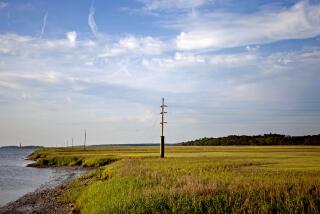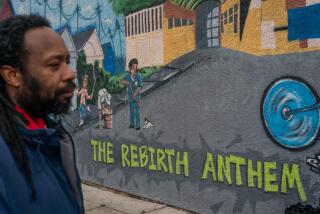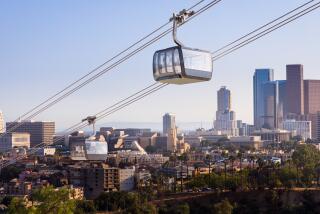Santa Susana Knolls Has Natural Animosity With Simi
- Share via
Holly and Don Huff began building their rural dream house in the 1970s. What started as a tiny bungalow in the woods of the Santa Susana Knolls was transformed through the Huffs’ own labor into a rustic, two-story hideaway of redwood and stone.
The Huffs and their neighbors--an eclectic group of artists, musicians and nature lovers--came to this hamlet just west of Chatsworth seeking a laid-back refuge from the hustle of city living.
Then the city and the hustle came to them.
Through development and gentrification, Simi Valley, the city just next door to the west, has sidled up close to the Knolls, leaving the little community--which languishes in an unincorporated portion of Ventura County--in a sort of political limbo.
While Simi Valley has no jurisdiction over the Knolls, many of the city’s decisions are changing the face of the land. And that, say Knolls residents, affects them.
For residents of the boulder-encrusted corner of the county, those issues amount to squabbles over saving nearby eucalyptus trees from city chain saws, preserving a landmark rock that marks the entrance to Simi Valley from the Santa Susana Pass, or fighting the extension of a road that winds through the neighborhood to a new housing tract.
Dawn Kowalski, who moved to the Knolls with her husband, Michael, more than a decade ago, described the city’s approach to the neighborhood as “sad, unneighborly and sometimes hostile.”
For her and other Knolls residents, who turn up time and again at civic meetings, it’s a matter of preserving a way of life.
But to many city officials, Knolls residents are often perceived as intractable and incapable of listening to the facts. And their repeated scuffles with the city are seen as a tug of war over how much say the rural residents should have in the goings-on of Simi Valley.
“They want it all their way or nothing, and that’s wrong,” Councilwoman Barbra Williamson said. “I expect them to work with us when there’s a problem and not totally against us.”
If Knolls residents want to get involved, some officials say, they should join the city. But Knolls residents say the city wouldn’t have them. And so it continues.
“I think they’re very territorial,” Williamson said of the rural residents. “They have to be on their guard constantly to make sure there’s no infringement on their lifestyle.”
Fighting for Rocks and Trees
The battles may seem like minutiae to some, but for Knolls residents the trees and rocks are worth fighting for. They are icons of the neighborhood’s character.
The most recent controversy erupted over a proposal to continue a county road through the area and connect it to a proposed housing tract on the neighborhood’s western border. The road would be used only in emergencies, but Knolls residents are worried a stream of cars winding down the narrow byway would interfere with their own efforts to escape from a fire or other disaster.
The developer, who wants to build apartments and single-family homes in an area that would be known as Parker Ranch, proposed changing the access road’s location. But Knolls residents still aren’t satisfied with their treatment by the city.
“They hate us,” Holly Huff said. “That’s the bottom line.”
The question of the Knolls’ voice in city issues came to a head this fall when residents argued for their right to vote in one of the city’s neighborhood councils. The grass-roots groups, scattered throughout the city, make recommendations to officials about proposed housing and other issues. Knolls residents wanted to ensure they would have a say in development that encroaches on their borders.
In the end, Mayor Bill Davis told them, “If you don’t live in my city and you don’t vote for me, you shouldn’t come to me and tell us how to run our city.”
But that hasn’t stopped Knolls residents from trying--often with results that both sides see as positive.
When a city arborist found that eucalyptus trees on city land near the Knolls were ailing and doomed them to the chain saw, Huff helped hire the Knolls’ own arborist for a second opinion, which conflicted with the first. The city listened, and many of the trees were saved.
Huff, Dawn Kowalski and other Knolls residents also fought to preserve the giant landmark boulder that looms like a sentinel over the neighborhood’s eastern border. A developer proposed chiseling into the rock to make way for a wider road, more traffic and new housing. In the end, residents got the rock established as a historical landmark. It stands today as it did when Chumash Indians lived in the area.
And although the battles often rage over boulders and trees, residents have taken on some major issues as well.
Knolls locals have been a strong voice in the cleanup and health probe at Rocketdyne’s nearby Santa Susana Field Laboratory. And they were part of the effort to establish the neighboring Corriganville movie ranch as a public park and save the former Hollywood filming mecca from becoming an industrial park.
A Feisty History
Compared with the middle-class suburbia of Simi Valley, the Knolls has a rich and sometimes tawdry history of independence. When rustic cabins sprang up during the 1920s, the area became the site of a brothel and Prohibition-era speak-easy.
The Knolls area was home to a religious cult in the 1920s. According to local legend, its members ritually sacrificed white mules, dogs and other animals.
These days, Knolls residents are mostly professionals and families. But the area’s history and spirit foster a spunky brand of political activism.
Scuffles with City Hall go way back. Holly Huff said Davis hasn’t forgiven Knolls residents for not endorsing him during his 1990 run for a county supervisor seat when they accused him of being in cahoots with a developer.
But Davis said Knolls residents should annex into the city or pipe down.
“It would be no different than saying we should let people from Chatsworth come over and vote on a city issue,” Davis said. “We have listened to them and acted accordingly. If they want to vote as a city person and come to us and ask us to annex them into the city, I’m sure the City Council would welcome them in.”
City Manager Mike Sedell said officials have made an effort to include Knolls residents in discussions.
“Their property taxes go to the county, not the city. Does that mean they don’t have valid points, that they shouldn’t be listened to?” he asked. “Not at all.”
Although only a core of activists speaks at civic meetings, the spirit of protest permeates the community, said Knolls local Marie Mason. One of the cornerstones of that activism is the Knolls homeowners association, which formed in 1969.
In a neighborhood where homes straddle boulders and horses chew hay in driveways, the association was not created to regulate neighborhood aesthetics, said Mason, the group’s vice president.
Instead, it exists mostly to hash out the community’s case on broader issues. The information trickles through a grapevine of neighbors, most of whom know each other on a first-name basis.
Holly Huff and Dawn Kowalski, who have been two of the Knolls’ most vocal residents, say some pundits have coined not-so-nice names for the pair.
But as long as the area is still a rustic haven, they will keep fighting for it.
They drive past the old brothel, which sits abandoned and decaying on a hilltop. They watch the eucalyptus, which they helped save, sway in the wind. And as the sun sets behind the hills, they hike an open pasture behind the towering rock they lobbied to establish as a historical landmark. Huff scales the massive boulder and thrusts her head into a small crevice. She marvels at the crumbling texture of the small cave’s walls, dusts off her hands and leaps back to the earth.
Knolls residents love the daunting, narrow roads that spiral around the hilltops. They like their neighborhood’s nighttime darkness--street lights would dim the stars that dominate the sky. They want their privacy.
“If you don’t have that kind of spirit,” Mason said, “you don’t last here.”
More to Read
Sign up for Essential California
The most important California stories and recommendations in your inbox every morning.
You may occasionally receive promotional content from the Los Angeles Times.










